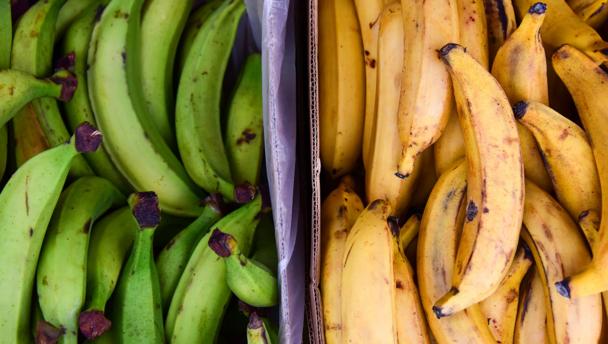Marcus Samuelsson is a European and an African. As a three year old, he and his older sister were adopted from an Ethiopian orphanage and taken to Sweden to live their lives with a food-loving family.
Now Samuelsson is well-known in international circles as the chef who championed the quality and inspiration behind modern Scandinavian cuisine. His arrival at the famous New York restaurant, Aquavit, saw it ranked three stars from the NY Times and spawned a beautiful book by the same name.
In his other book, The Soul of a New Cuisine: A Discovery of the Foods and Flavors of Africa, Samuelsson explores the continent of his birth.
One of his recipes is a West African banana fritter, which I transformed into something a little more special by using plantains, and covered off the last of my West African cooking challenge for 2008.
Plantain Fritters
Recipe from The Soul of a New Cuisine by Marcus Samuelsson. Makes 12 fritters.
Ingredients:
3 ripe plantains
½ cup fine cornmeal
1 teaspoon sugar
¼ teaspoon salt
3 – 4 cups canola oil, for deep-frying
2 tablespoons honey
Method:
1. Combine the plantains, cornmeal, sugar, salt in a bowl and mash with a fork until smooth.
2. Heat 2 ½ inches of oil in a deep pot to 180’C.
3. Working in batches, add a heaped spoonful of the plantain mixture and fry until golden brown (about 2-3 minutes). Turn once halfway through cooking.
4. Remove from the oil and drain on paper towels.
5. Before serving, drizzle with honey.
I have blogged about plantains before for Weekend Herb Blogging and because I am flat out at work these days I'm going to be really naughty and copy straight from an old post:
Plantains are very starchy fruit which are used more like a vegetable. They should usually be cooked before eating and are low in sugar content, although I suppose a black plantain (at its ripest stage) may be eaten raw.
It seems that green plantains are best for savoury dishes but when they get a little riper you can use them for desserts too.
Green plantains are very hard to peel and I used a potato peeler to get into the starchy flesh. In fact it’s so starchy my hands were coated with sticky starch even after washing.
Apparently they come from tropical South East Asia, particularly the Malay Archipelago, but they feature heavily in the diets of the Caribbean and West Africa. There they use plantains the way Europeans use potatoes: they can be fried, boiled, mashed or baked.
In Vietnam and Laos the plantain flowers are used to make salads and soups and the large leaves can be used as plates or wraps when cooking food. As the plant will only fruit once, after the harvest the stalk can be peeled to reveal a soft shoot which is also eaten.
Our WHB host for the week is Ivy from Kopiaste, a beautiful food blogger from Athens who often highlights the Cypriot delicacies of her homeland.
References
http://www.grabemsnacks.com/what-is-a-plantain.html
http://en.wikipedia.org/wiki/Plantains
Tags: morsels and musings food blog food and drink australia recipes weekend herb blogging whb dessert fritters plantains plantain fritters plantain fritter recipes dessert recipes fritter recipes plantain recipes west african recipes west african food west african cuisine





Pity we don't have plantains here in Greece, but your recipe sounds very interesting. Thanks very much Anna for participating.
ReplyDeleteI've only had plantains once, and your recipe sounds much better than the ones I had in a restaurant in Florida. They were tasty though; great entry.
ReplyDeleteThis looks delicious! I've just stumbled onto your great blog looking for a way to serve spanish anchovies. You reminded me to pick up Frank Camorra's book from the bookshelf!
ReplyDeleteBut I've recently realised I can get plantains here in Melbourne and have been itching to try them out with some ideas we picked up in Mexico. Can I ask: when you say 'ripe', do you mean black?
can you let me know where you got your plantain from in Melbourne?? looking to get some.
ReplyDeleteI've seen them (very green) at a couple of stalls at Preston market, at one stall at Victoria market (in the row beside the organic rows). And they're also often at Casa Iberica (Johnston St, Fiztroy).
ReplyDeletethanks for helping out lexi, and yes i meant kind of squishy and a little coloured when i said "ripe"
ReplyDelete